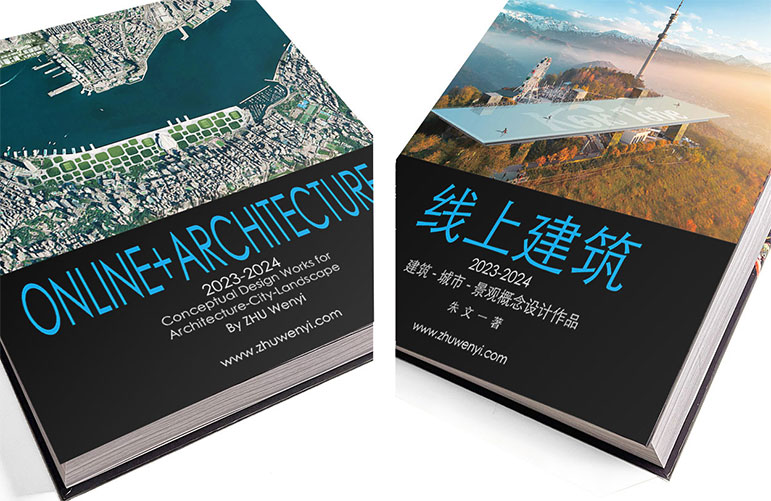
“线上建筑”再思考
《线上建筑》(2023-2024)自序
两年前的2023年5月,我在完成的《线上建筑》(2013-2023)和《线上建筑学理论》两本书中提出并详尽阐述了“线上建筑”和“线上建筑师”以及“线上建筑学”的概念。从书名可以看出,这本《线上建筑》(2023-2024)是我提出的线上建筑及其理论的进一步推衍。经过两年多的时间,我对“线上建筑”概念又多了些许思考。
我提出的中文“线上建筑”指的是网络上存在的建筑图片、视频以及文字等。其中“建筑”的含义与现实中建筑一词的语义相同。也就是说,“线上建筑”是线上建筑物与构筑物的统称,它同样具有科学与艺术、理工与人文相结合的内涵;而作为研究线上建筑及其环境的学科,“线上建筑学”是一门横跨工程技术和人文艺术的学科;“线上建筑师”则需要经历建筑学专业教育的全过程学习和实践。
关于英文“Online Architecture”和“Online Architect”的含义,中文对应的是“在线架构”和“在线架构师”。对此,我不想展开讨论;只是感觉,就目前学科发展的状况而言,中文的名称似乎显得更加贴切。我想表达的是,在英语语境中,原本现实世界中的建筑(Architecture)和建筑师(Architect)与网络世界中的建筑(Architecture)和建筑师(Architect)尽管用了同样的名词,但建筑学和计算机这两个领域之间少有来往,各自发展,因而相安无事。在现实世界中,建筑师总体负责盖房子、建城市、搞景观;在网络世界中,架构师(建筑师)整体把控网络世界里软件和硬件的整合。
然而,随着人工智能的快速迭代,当它进化到可以生成符合现实世界中物理学规律的“网络世界”空间景象的时候,建筑学和计算机两个领域之间的界限就被打破了。也就是说,网络世界与现实世界有可能遵循同样的建筑规律。现实世界里的伟大建筑“金字塔”与网络世界中的“线上金字塔”遵循相同的重力等物理规律和美学原理。
在这样的情况下,有必要重新审视网络空间中的“建筑”、“建筑师”以及“建筑学”概念。这就是我提网络世界中的“线上建筑”、“线上建筑师”和“线上建筑学”概念的由来。在中文语境中,这样的概念不会引起歧义,因为“在线架构”和“在线架构师”已经被计算机学科领域广泛使用。但在计算机领域的英文语境中,被普遍使用的词语是“Online Architecture”和“Online Architect”。为了避免引起歧义,我提出的“线上建筑”、“线上建筑师”和“线上建筑学”所对应的英文也许是“Online+Archiecture”、“Online+Architect”和“A Theory of Online+Archiecture”比较合适。
辨析现实世界与网络世界中的建筑概念尽管很重要,但也只是第一步,最要紧的是发掘和提出网络世界中“线上建筑”、“线上建筑师”和“线上建筑学”自身的空间规律。从2015年开始,我相继完成了万能视角建筑学(2015-2020)、屏上建筑学(2020-2021)以及线上建筑学纲要(2023)等著述以及大量概念设计作品。这些探索性的研究旨在揭示网络世界里“线上建筑”特有的空间特征、“线上建筑师”职业存在的可能性以及“线上建筑学”的学科边界等。
最后谈谈本书的成稿过程。这本题为《线上建筑》(2023-2024)的书收录了我于2023年6月至2024年12月期间完成的95个建筑、城市、景观概念设计作品。
自2023年6月,我开始了中国建筑、城市、景观线上游的退休生活;一年后的2024年8月,我完成了中国31个省市自治区和港澳台地区的52个概念设计作品。这部分的成果已经于2025年3月26日编辑和排版完成《朱文一线上建筑中国》初稿。2024年8月至11月,我完成了亚洲部分国家的29个概念设计作品;至12月底,完成了欧洲部分国家的14个概念设计作品。2024年3月至12月,我完成了89个概念设计作品,差不多每个月完成9个设计作品;平均每3天多完成1个设计方案。尽管只是概念设计作品,但个人独自完成从构思到设计到表达全过程,能达到这样的高效率,不说后无来者,前无古人是一定的。
面对充满未知的“线上世界”,我的种种尝试当然是很初步的;但不断开拓是我坚持的学术精神。在编辑和排版这本《线上建筑》(2023-2024)的时候,我已经在筹划《朱文一线上建筑亚洲》和《朱文一线上建筑欧洲》两本书的整理和排版事宜。
朱文一
成稿于2025年3月26日
修改于2025年4月13日
ONLINE + ARCHITECTURE
SELF-PREFACE OF ONLINE+ARCHITECTURE
Two years ago, in May 2023, in my two completed books, Online Architecture (2013-2023) and A Theory of Online Architecture, I proposed and elaborated on the concepts of Online Architecture, Online Architect, and A Theory of Online Architecture. As can be seen from the title, this book Online+Architecture is a further derivation of the concept of Online Architecture and its theory that I proposed. After more than two years, I have gained some additional thoughts on the concept of Online Architecture.
The term Online Architecture in Chinese I proposed refers to architectural images, videos, and texts existing on the Internet. The meaning of architecture here is the same as that in the real world. That is to say, Online Architecture is a general term for buildings and structures in the online world, which also has the connotation of combining science and art, as well as engineering and humanities. As a discipline that studies online architecture and its environment, A Theory of Online Architecture is a discipline that spans both engineering technology and humanities and arts. An Online Architect needs to go through the entire process of learning and practice in the field of architecture education.
Regarding the meanings of the terms Online Architecture and Online Architect in English, the corresponding terms are Online Framework (in the context of computer science) and Online Framework Engineer (in the context of computer science) in Chinese. I don't want to discuss this in detail. It just seems to me that, given the current state of discipline development, the Chinese names seem more appropriate. What I want to express is that in the English context, although the same nouns Architecture and Architect are used for both the architecture and architects in the real world and those in the online world, there is little interaction between the fields of architecture and computer science, and they develop independently without conflict. In the real world, architects are generally responsible for designing buildings, cities, and landscapes. In the virtual world, architects (in the context of computer science) overall control the integration of software and hardware in the online world.
However, with the rapid iteration of artificial intelligence, when it evolves to the point where it can generate spatial scenes in the Online World that conform to the laws of physics in the real world, the boundary between the fields of architecture and computer science is broken. That is to say, the online world and the real world may follow the same architectural principles. The great architecture Pyramid in the real world and the Online Pyramid in the online world follow the same physical laws such as gravity and aesthetic principles.
In this situation, it is necessary to reinterpret the concepts of architecture, architect, and architecture as a theory in the online world. This is the origin of the concepts of Online Architecture, Online Architect, and Online Architecture Theory in the online world that I proposed. In the Chinese context, these concepts will not cause ambiguity because the terms Online Framework and Online Framework Engineer have been widely used in the field of computer science. However, in the English context of the computer science field, the commonly used terms are Online Architecture and Online Architect. To avoid ambiguity, the terms corresponding to my proposed Online Architecture, Online Architect, and Online Architecture Theory in English might be more appropriately Online+Archiecture, Online+Architect, and A Theory of Online+Archiecture.
Although distinguishing the concepts of architecture in the real world and the online world is important, it is only the first step. The most crucial thing is to explore and propose the spatial laws of Online+Architecture, Online+Architect, and Online+Architecture Theory in the online world. Since 2015, I have alreadycompleted theories such as God's-Eye-View Architecture (2015-2020), On-Screen Architecture (2020-2021), and Outline of Online Architecture (2023-) as well as a large number of conceptual design works. These exploratory studies aim to reveal the unique principals of Online+Architecture in the online world, the possibility of the profession of Online+Architect, and the disciplinary boundaries of Online+Architecture Theory.
Finally, let's talk about the process of writing this book. The book, titled Online Architecture (2023-2024), is a collection of 95 conceptual designs for architecture, urban, and landscape that I completed between June 2023 and December 2024.
Since June 2023, I have started my retirement life in the online tour of architecture, city, and landscape in China; A year later, in August 2024, I completed 52 conceptual designs in 31 provinces, municipalities and autonomous regions in China, as well as Hong Kong, Macao and Taiwan. On March 26, 2025, the book draft ZHU Wenyi Online+Architecture in China was edited and typeset. From August to November 2024, I completed 29 concept designs for some countries in Asia; By the end of December, 14 concept design works in some European countries had been completed. From March to December 2024, I completed 89 conceptual design works, almost 9 design works every month; On average, 1 design proposal is completed every 3.3 days. Although it is only a conceptual design work, it is certain that an individual can complete the whole process from conception to design and drawing alone, not to mention that there is no one who has never come before.
For the Online World full of unknowns, my attempts are of course very preliminary; But continuous development is the academic spirit that I adhere to. When editing and publishing the book Online Architecture (2023-2024), I was already planning the collation and layout of the two books, ZHU Wenyi Online+ Architecture in Asia and ZHU Wenyi Online+Architecture in Europe.
ZHU Wenyi
Written on March 26, 2025
Revised on April 13, 2025